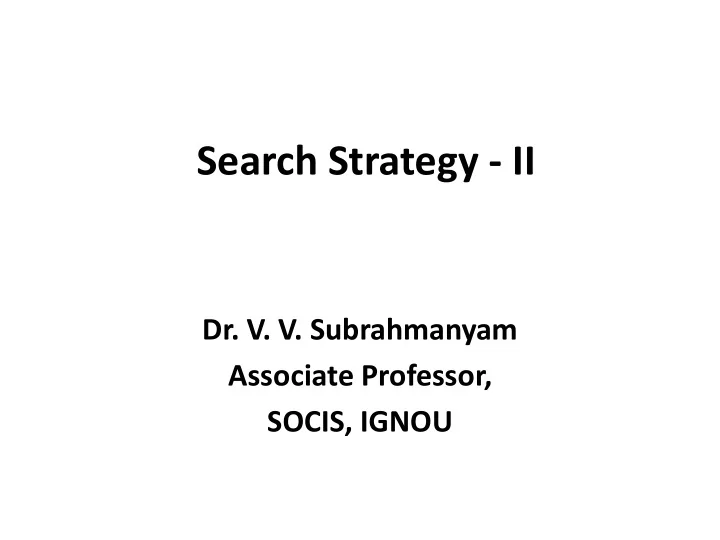

Search Strategy - II Dr. V. V. Subrahmanyam Associate Professor, SOCIS, IGNOU
Mismatch Between Information Need and Search Results • Problems of online searching identified by Fenichel’s study (1980-81) are: – Approaches to searching vary from user to user – Major problems are with the search strategy and not with the mechanics of the retrieval system – Most of the users do not make full use of online interactive facilities – Lack of skills, charging policy, search environment and nature of question
Major causes for deviation (Guinchat and Menou, 1990, p.314) • Information need as perceived by end-user • Information need as expressed in end-user’s query • Information need as interpreted by Information Specialist • Query formulation in the language of the system • Formulation of search expression and strategy
Contd… • Search and retrieval operations • Intermediate results • Final results
Major Approaches in Searching (Markey and Atherton, 1981; Harter, 1986, Hartley 1990) • Briefsearch • Block-building method • Successive fractions method • Citation Pearl Growing method • Starting a search with the most discriminating facet first
Contd… • Starting the search with the lowest posted or the most specific term as measured against the file • A combination of two or more of the above methods which is useful in actual practice of searching.
Briefsearch • It is a quick and relatively less expensive way of getting a rough idea about what a database holds about a subject. • With the help of many more additional terms derived from the first briefsearch further search steps can be proceeded. • One may not adopt this technique for a full fledged search.
Building Block Method • Reduce a request into a series of sub- problems. • This strategy is logical in construction of search mechanism but takes time in keying-in and requires knowledge of the appropriate vocabulary.
Example • Software packages for information retrieval – S1 software OR packages OR software packages – S2 information retrieval – S3 S1 AND S2 *OR and then AND
Successive Fractions Strategy • This approach is a way of reducing a large set created using AND or NOT • Example: • Swimming and physical fitness of women – S1 swimming AND (wom?n OR female?) – S2 S1 AND fit? – S3 S2 AND year >= 1995
Citation Pearl Growing Method • It begins with a very small initial set, even a single term known to be relevant to the query. • The resultant retrieval provides additional relevant terms. • These can be used to carry out further searches on the subject.
Precision Devices • Precision devices are used to restrict the no. of records retrieved. • Such devices enable the coordination of linking information at various stages of document indexing, search, and retrieval processes.
Recall devices • Recall devices are used to increase the no. of relevant references retrieved by a search expression. • The devices includes synonym control, hierarchical term linkage, associative term linkage, control of work forms, summation of document sets and bibliographic coupling.
Recommend
More recommend